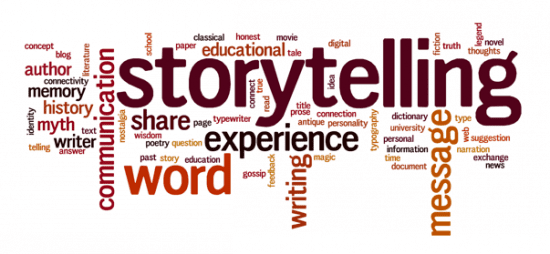Don't lose sight of your brand personality your #video strategy
Storytelling has been around for millennia. As children we grew up with tales and fondly remember stories opening with 'Once upon a time…'. With this nostalgic link in mind, businesses use stories as central parts of their advertising and messaging campaigns when seeking to humanise their brands.
 Source: Shutterstock
Source: Shutterstock
Today, social media are an ideal vehicle to distribute these stories. And with good reason, the online landscape is becoming noisier every day. Storytelling is an effective method for getting heard above the din.
On a practical level, storytelling is a great way to engage, motivate and connect with your readers. But with so much content being shared daily by so many brands, the written word just doesn’t have the same impact anymore -- particularly for the reader who has grown up expecting a multi-media experience.
These folks need content that can appeal to their visual, auditory and cultural knowledge base.
Animated video marketing is a perfect example of how stories can frame your product like never before.
Why use story telling in your animated videos?
 Source: Shutterstock
Source: Shutterstock
- Simple takeaways. Storytelling makes it easy for the viewer to follow what you’re saying. Your messaging is much more memorable and compels the viewer to share your content.
- Emotional connection. Animated videos embrace the old adage of 'show don’t tell.' You can only write 'Our product is the best' so many times before people start questioning what you really mean. With animated videos you can share a clear story of your product’s value proposition.
- Calls-to-action. Video compels viewers to act in ways the written word can’t. By depicting the action on the screen, you can show exactly how the user will benefit, yielding higher engagement rates. Telling stories are much more likely to motivate, inspire action and excite your audience.
- Trust and loyalty. By clearly illustrating how your product works, you give potential customers a heightened sense of your company’s values and mission.
How to create a story for your animated video
- With all good stories (whether you’re a presenter conducting your audience, or a brand trying to get key messages out there) you need to have the structure in place before you start. So first hash out the beginning, middle and ending.
- Tighten up how your story flows as you want to capture the attention of your viewers, draw them in and make sure they stay with you to the end; there’s nothing worse than a video that meanders and doesn’t get to the point!
- Clearly communicate how your product can help. What’s the problem or challenge that your customer or potential client faces, and how can you address them? Don’t sell the features; people don’t buy features. You need to have a value proposition and identify the benefits for potential customers.
- Use characters. You want to ensure that the characters you depict enable your audience to connect emotionally to your product. When choosing your leading character consider basing him or her on the problem your company helps solve for the viewer.
- Know your audience / customer and always focus on them. User studies can help target your message for greater efficacy.
Content planning
Now it’s time to think about context. A great way of doing this without using lots of text is through themes and settings. So, for example, if you’re talking about an office environment you can use themes, props and settings associated with the look and feel of office life.
At GoAnimate, we use various different types of themes and styles to help you create your animated video and share your story. Below are our favourites:
Whiteboard animation is one of GoAnimate’s most popular themes. It includes thousands of hand-drawn assets like props and backgrounds, plus hundreds of character actions that fit a wide variety of business settings.
Another benefit of using Whiteboard animation is that it’s perfect for nuanced topics that need to be explained to a wider audience. The light look and abstraction away from irrelevant details really help to focus the viewers’ attention.
2D Animated videos look very similar to popular TV programmes. They are easy to absorb and help increase speed of engagement. Similar to whiteboard animation, they abstract away from irrelevant detail, enabling the communication of complex ideas in a simple way. This style is perhaps better for storytelling than whiteboard animation, since it’s easier for the characters to make an emotional connection with your audience.
- Animated video infographics
Animated video infographics are our latest feature and really do bring data to life! Proprietary data can be powerful. But it’s often difficult for the storyteller to portray in an engaging and effective way. That’s why animated infographics work so well. Not only do they showcase each of the components but they also make it much easier for the viewer to understand and absorb. Since they are still fairly new, it’s a great way to make your data-heavy content stand out and really 'wow' your customer.
Are you using storytelling as part of your content marketing? What type of animation style videos do you find the most engaging? Please do leave a comment and share this post to let us know your thoughts!

Thanks to Gary Lipkowitz for sharing his thoughts and opinions in this blog post. Gary has been waiting for convergence his whole life. He has always loved media, entertainment and technology and is really glad he gets to ‘work’ in these fields. He joined
GoAnimate in 2011, after spending ten years in Asia working with Wego.com, Mediacorp Raintree Pictures, Yahoo! Southeast Asia and MTV Asia. He also spent a few years dubbing anime franchises such as City Hunter, Legend of Crystania, Queen Emeraldas, Tekken and Sonic the Hedgehog for ADV Films.He holds a BA (Magna Cum Laude) from NYU, an MFA in Film from Northwestern, and an MBA (With Distinction) from INSEAD. He enjoys playing ice hockey and collecting Balinese art. You can connect via
LinkedIn.




 Thanks to Gary Lipkowitz for sharing his thoughts and opinions in this blog post. Gary has been waiting for convergence his whole life. He has always loved media, entertainment and technology and is really glad he gets to ‘work’ in these fields. He joined
Thanks to Gary Lipkowitz for sharing his thoughts and opinions in this blog post. Gary has been waiting for convergence his whole life. He has always loved media, entertainment and technology and is really glad he gets to ‘work’ in these fields. He joined 

